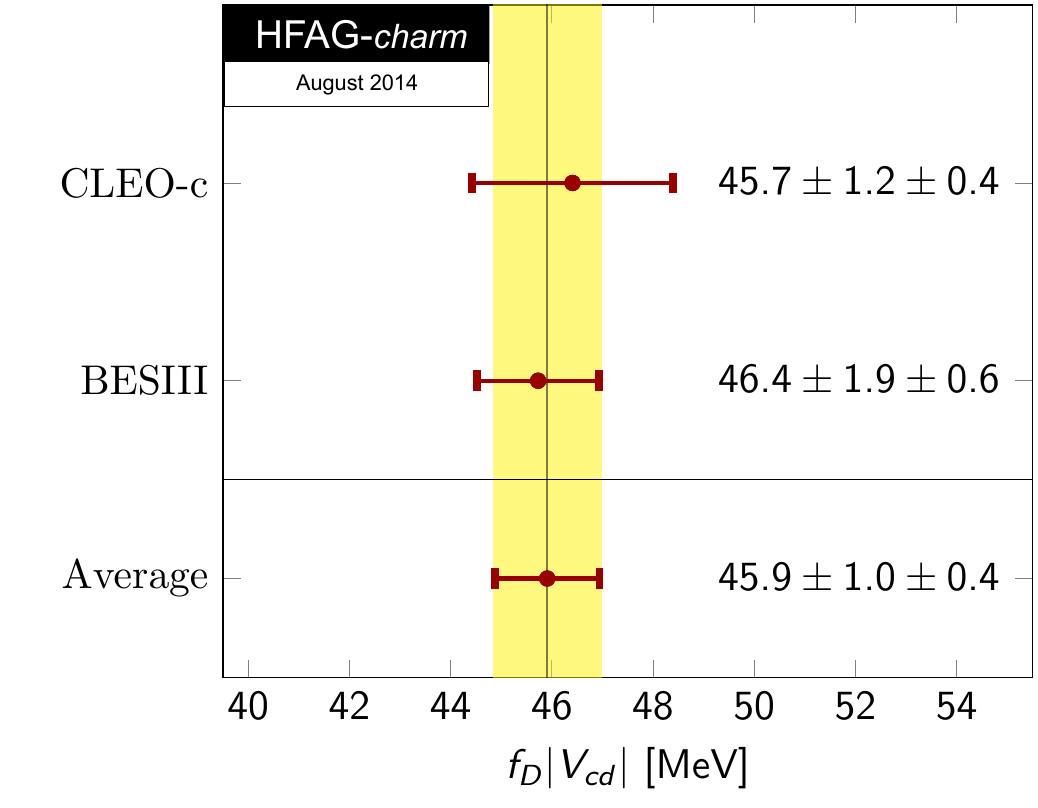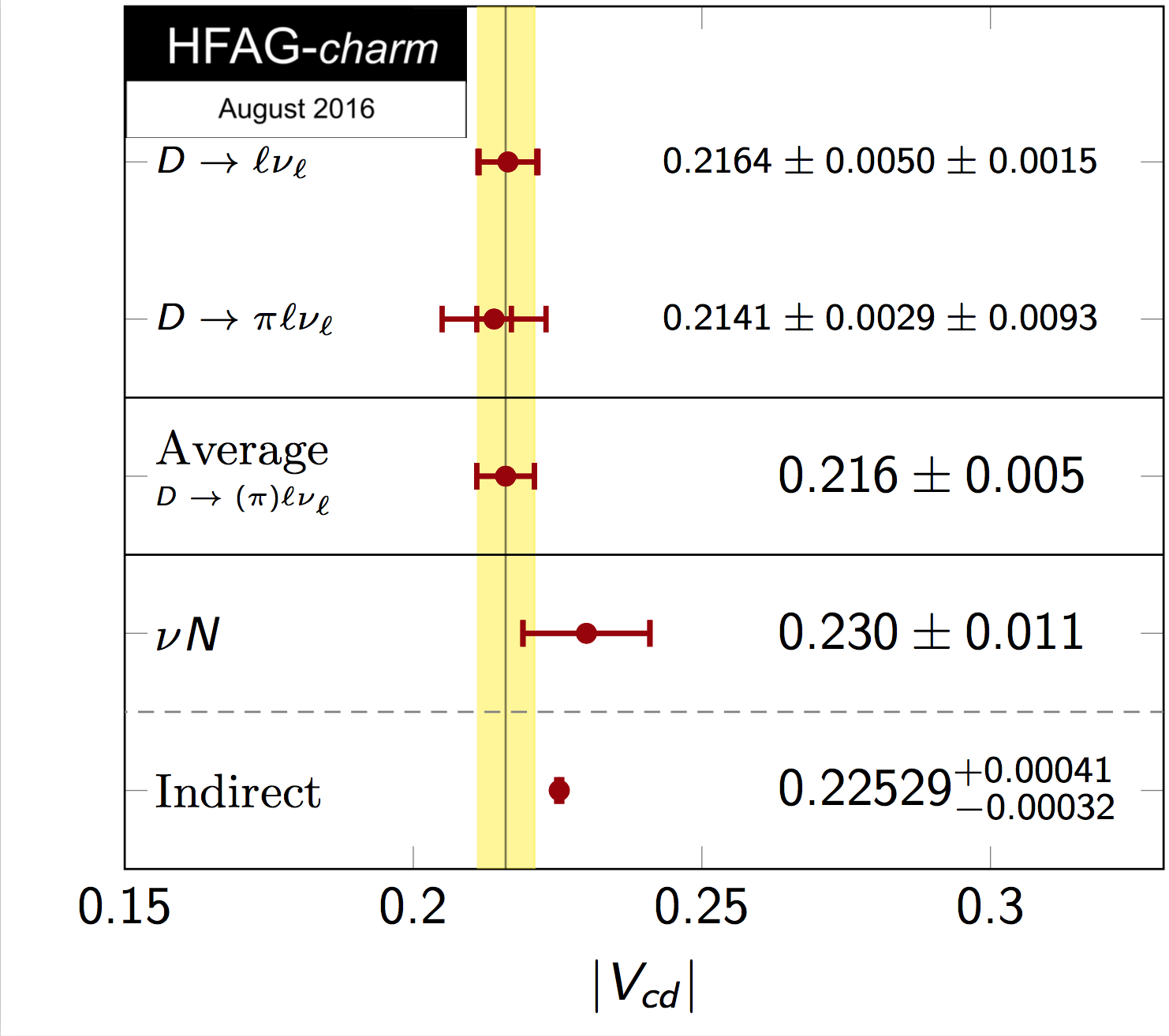World Average Value for the Vcd
from leptonic D+ decays
(updated 10 October 2016)
People working on this:
Anze Zupanc
The branching fraction of leptonic decays of pseudo-scalar mesons
that proceed via the annihilation of the initial quark-antiquark pair (cd
in the case of D+ meson) into a virtual W+ that finally materializes as an antilepton-neutrino pair (lν, where l = e, μ, or τ) is
given in the Standard Model by
Br(D+→ l+ν) = GF2/(8π)τDfD2|Vcd|2MDMl2(1-Ml2/MD2)2.
Here, MD is the D meson mass, τD is its lifetime, Ml is the charged lepton mass,
|Vcd| is the magnitude of the CKM matrix element, and GF is the Fermi coupling constant. The parameter
fD is the D meson decay constant and is related to the wave-function overlap of the meson's
constituent quark and anti-quark. Within the SM, the decay constants have been predicted using several
methods, the most precise being the lattice gauge theory (LQCD) calculations. The Flavor Lattice Averaging
Group combines all LQCD calculations and provides averaged value for fDLQCD=(212.15 ± 1.45) MeV that is used within this section to extract the magnitudes of the |Vcd| CKM
matrix element from experimentally measured branching fractions of leptonic D+ meson decays.
We use measurements of the branching fraction Br(D+→ μ+ν) from CLEO
and BESIII to calculate its world average (WA) value. Uncertainties of the two measurements are considered to be uncorrelated. We obtain
Br(D+→ μ+ν)WA = (3.74 ± 0.17) × 10-4,
from which we determine the product of the decay constant and the CKM matrix element using the equation from the top of the page to be (figure)
fD|Vcd| = (45.9 ± 1.1) MeV,
where the uncertainty includes the uncertainty on Br(D+→ μ+ν)WA and external
inputs. Using the LQCD value for the decay constant, fDLQCD=(212.15 ± 1.45) MeV,
we finally obtain the CKM matrix element Vcd to be
|Vcd|D→ lν = 0.2164 ± 0.0050(exp.) ± 0.0015(LQCD),
where the uncertainties are from the experiments and lattice calculations, respectively. The value is found to be consistent
with the one determined from the semileptonc D→ πlν decays, |Vcd|D→ πlν = 0.2141 ± 0.0029(exp.) ± 0.0093(LQCD). Averaging both, assuming 100% correlation between the LQCD uncertainties, and none between the experimental uncertainties, gives (figure)
|Vcd|D→ (π)lν = 0.216 ± 0.005.
Assuming unitarity of the CKM matrix, the value of the element relevant in the case of leptonic D+ decays
is known from the global fit of the CKM matrix, |Vcd| = 0.22537+0.00068-0.00035. This value can be used to extract
the D meson decay constant from the experimentally measured product fD|Vcd|.
This leads to the experimentally measured D meson decay constant to be:
fD = 203.7 ± 4.9 MeV,
which is in agreement with the LQCD determination given above.

WA value for fD|Vcd|. For each point, the first error listed is the statistical
and the
second error is the systematic error. (Click on figure for higher resolution.)

Comparison of magnitudes of the CKM matrix element |Vcd| determined from the
leptonic and semileptonic D meson decays and from neutrino scattering data
and indirect determination from the global fit
assuming CKM unitarity. (Click on figure for higher resolution.)
External parameter values as taken from the 2014 Particle Data Book:
GF /(ℏc)3 =
(1.1663787 ± 0.0000006) × 10-5 GeV-2
Mμ = (0.1056583715 ± 0.0000000035) GeV/c2
MD = (1.86962 ± 0.00015) GeV/c2
τD = (1040 ± 7) × 10-15 s
This page is maintained by
A. Zupanc
and was last updated

